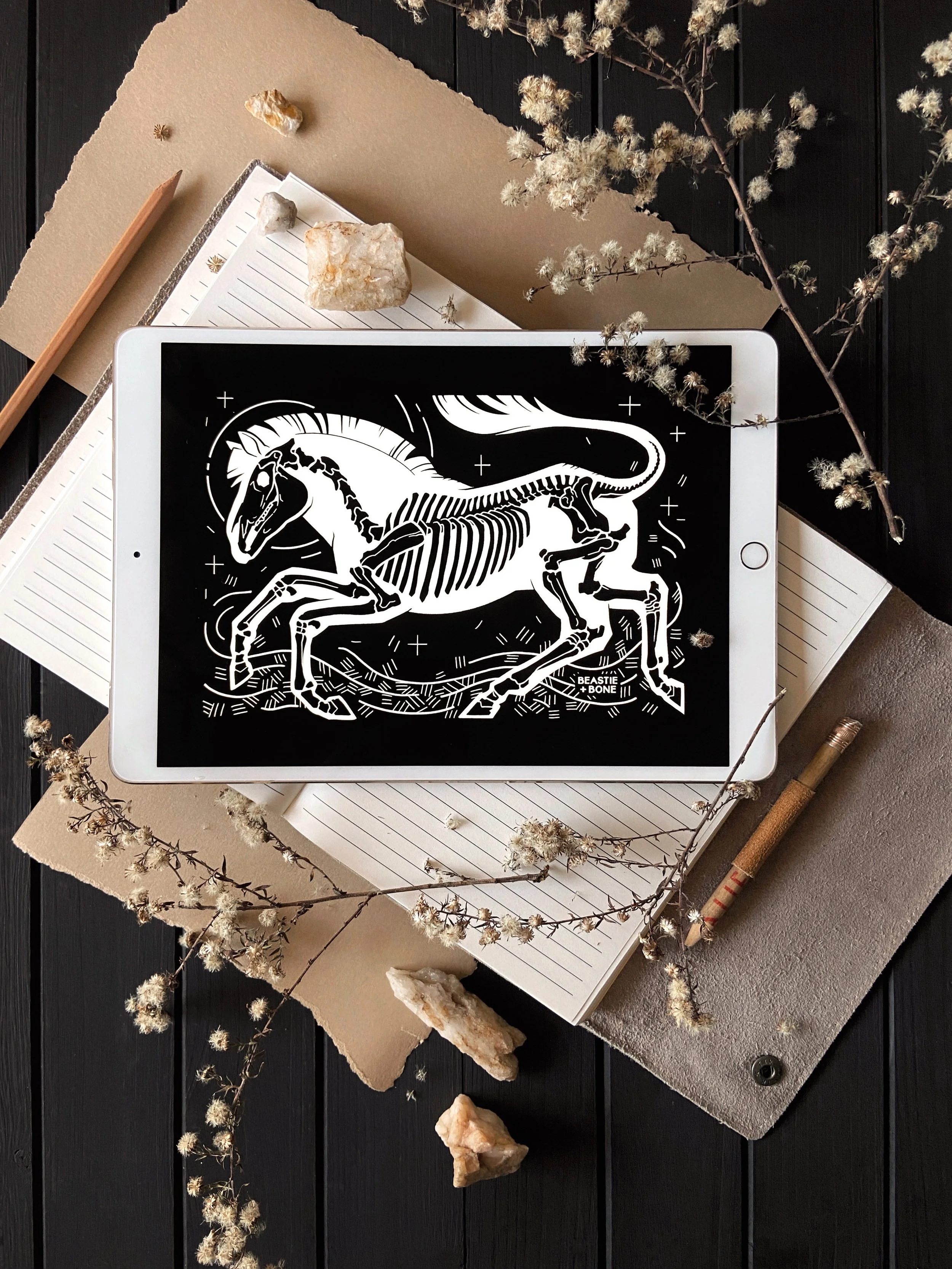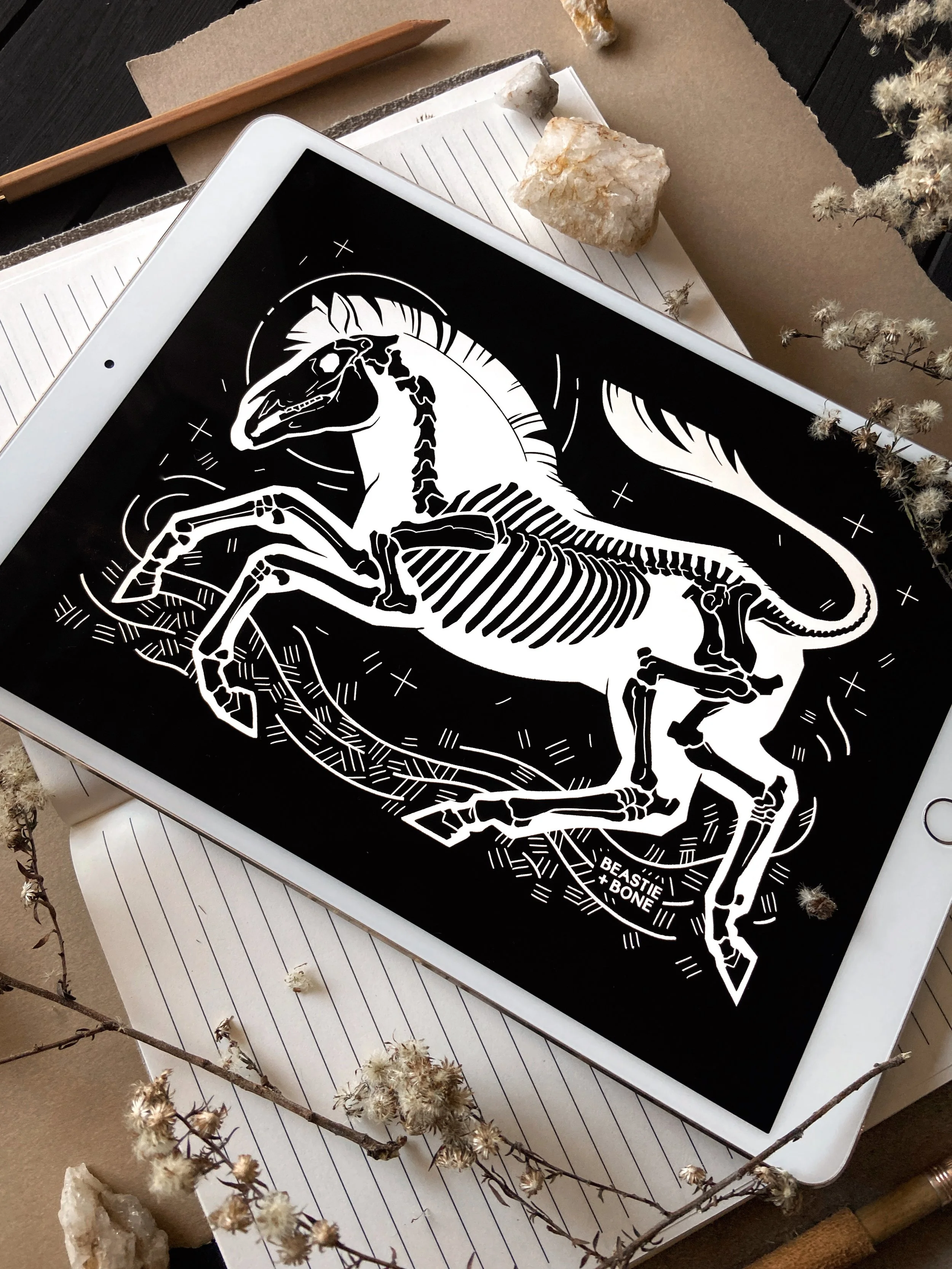Wild One - The Hagerman Horse
Creating this month's exclusive illustration was a wild ride. Not only is this the first megafauna illustration for the relaunched North American Project, which has opened a floodgate of inspiration for future art, but I learned so many fascinating things about the featured species for this month - Equus simplicidens - and its fossils.
More commonly known as the Hagerman Horse, E. simplicidens garnered this name from the location where a large number of its fossils have been unearthed: an ancient watering hole or catastrophic flood site (depending on which paleontologist you talk to) outside of Hagerman, Idaho. First discovered there in 1928, the fossilized remains of old, young, male, and female Hagerman horses are so numerous in this location that they are now the main attraction of The Hagerman Fossil Beds National Monument, and the state fossil of Idaho.
But while this abundance of fossils means a great deal has been learned about the history of the horse in North America - E. simplicidens is the oldest known member of the single-toed equine family - this knowledge has been gathered at a risk to scientists. That's because the geography around Hagerman, ID is rich in uranium. The fossilization process tucked high levels of the metal into the animals that died there, and that uranium is in those fossils, yet. The Hagerman horses are radioactive.
Special steps have been taken to protect scientists working with the Hagerman location E. simplicidens fossils, such as customized ventilation and climate control, and separate storage to keep the radon emitted by the "hot horses" at safe levels. Solutions are still being developed however, and this seems poetic, in a way. These prehistoric remains are problematic, and humans aren't quite sure how to handle them - just as the distant descendants of E. simplicidens are a point of friction in today's North American Wild West.
As mentioned earlier, the Hagerman horse is the oldest known member of the single-toed horse family. This means that, while smaller and more zebra-like than many of today's horses, E. simplicidens was the first true horse, and it was native to Pliocene North America. Herds of them raced the savannah-like areas of the continent from modern-day Idaho down to Mexico, congregating at watering holes like Hagerman to feed on the lush vegetation. But as the climate of the Americas dried out in the early Pleistocene, E. simplicidens migrated into Eurasia and eventually into Africa as well, following easier fodder. Eventually, they went extinct in North America. The Great Plains saw no horses until thousands of years later, brought back from Eurasia by invading Conquistadors, taken on by Native American Plains tribes, and eventually going feral.
Since then, the horse has become a poster child of North American western wilderness as the mustang. But debate is hot as those Hagerman fossils as to whether they should be. Yes, mustangs can claim original North American ancestry through E. simplicidens. But the arid conditions of much of today's West cannot support grazing like they used to, and the delicately balanced ecosystems are threatened by large groups of big herbivores that have few predators in the area. So, are mustangs rightful heirs to the glorious west, or are they an invasive species introduced by man?
This conversation is nuanced and complex, however, and this post of mine is already getting longer than usual. So if you'd like to learn more about the North American Mustang issue, I recommend this National Geographic article, which I found to be the most informative of the many I read in prep for creating this month's art. It is, however, fascinating that for the first time, a species in the North American Megafauna Project has a direct, modern descendant that is tied into the current ecology of the area it once lived in. It just goes to show how important it is to look to and learn from the past in order to promote a balanced and healthy world, and I'm excited to keep exploring this with you all in the new North American Megafauna Project art moving forward!
To create this month's illustration of E. simplicidens/Hagerman Horse, I took cues from the "glowing skeleton" stereotype with radioactive bones, cave paintings from the Pliocene and Pleistocene, and petroglyphs from the North American west. It was a fun lil extra to realize the hatching pattern I often do (3-5 lines repeated at different angles) when thinking closely resembles the repeated line texture found on a lot of petroglyphs. Guess I've just always had prehistoric art on the brain.
If you’d like to get this art as a miniprint or sticker, please join the Beastie and Bone Patreon to get access to the Patreon Exclusive Shop, where exclusive prints and stickers are available while stock lasts. Joining the Patreon or Beastie and Bone Happy Mail Club will also give you access to future exclusive art automatically!
Be well,
Stacia

